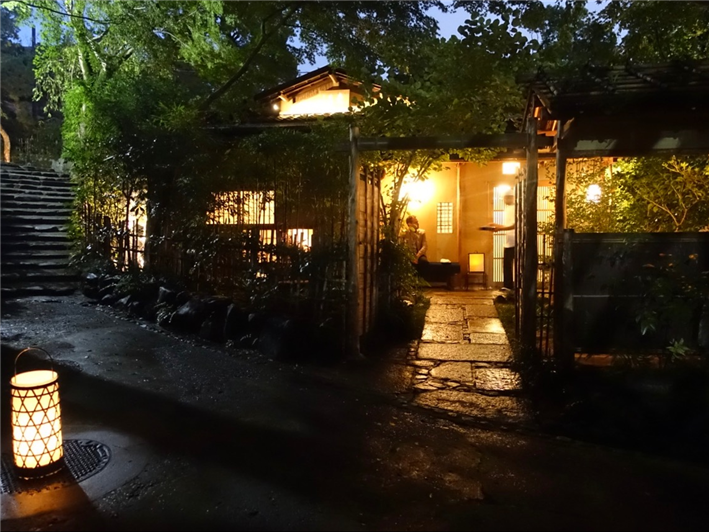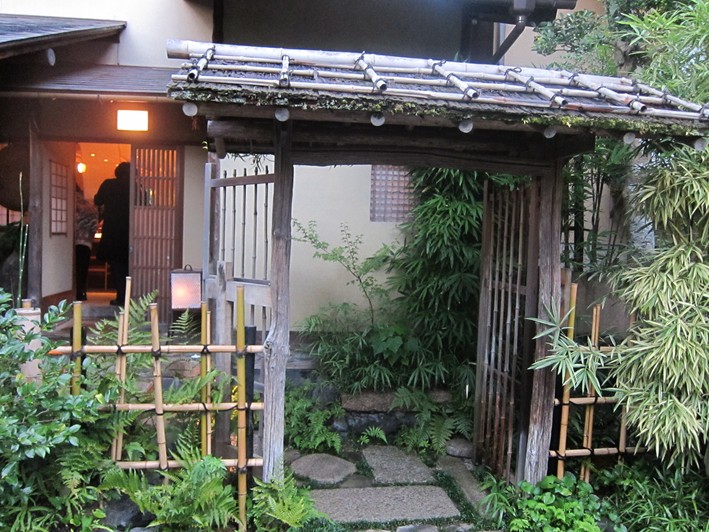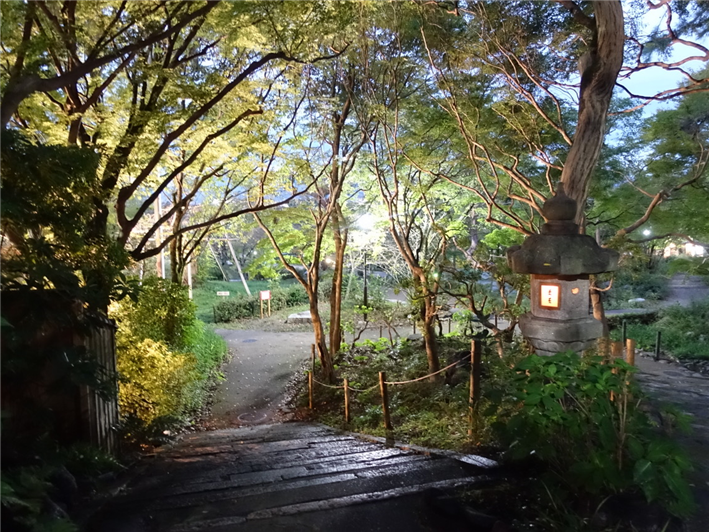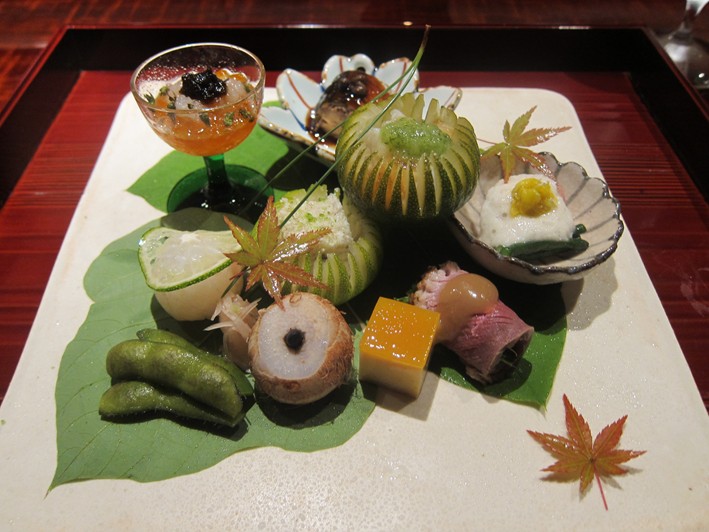Editor's note: since my last visit Mizai moved location to the other side of the park, and is larger, with perhaps 16 seats now.
Mizai is situated in the extensive grounds of Maruyama Park, nestling on a hillside just outside the centre of Kyoto over the bridge from the old geisha district of Gion. You need to bear this leafy location in mind when getting there, as a taxi will be able to take you to the temple/park entrance but not further, so you will have a short walk up the slope in order to reach the restaurant. An example of Japanese hospitality was shown by our hotel concierge, who was concerned that we might have trouble finding the building (there are several restaurants within the park grounds) and rang ahead to the restaurant to let us know that we were on our way; when out taxi arrived one of the chefs from the restaurant greeted us and escorted us to the door of Mizai. I am guessing that this is not something that has happened to you recently in, say, London or New York.
The usual discreet entrance leads to an initial waiting area (all diners eat together at the same time here) and then, through an entrance, to the dining room. This is set around a bar, with just eleven seats, and I could see over half a dozen chefs working to serve this number of diners. The head chef and an assistant do final preparation of dishes in front of you, and then hand you each plate in turn. This is kaiseki kappo cooking i.e. the same food as kaiseki but served at a counter rather than in a private room. The counter was a very attractive lacquered wood, and the plates and dishes themselves were very pretty, varying by course. There was considerable attention to detail, exemplified by a single white linen napkin for each diner of exceptional quality - the feel of the napkin in my hand was itself impressive, as fine a quality as I have encountered. Sadly the restaurant discourages photos, so you will have to rely on my descriptions (oddly, they relaxed at the end and the chef happily posed for a photo; however the one photo was I able to take of the food will give you an idea of how much effort goes into presentation).
To begin the meal a pair of lacquered bowls appeared, with some strikingly white polished rice (the Japanese cultivate over 500 different types of rice), wasabi soup and pickled vegetables; the wasabi here was the real thing, the wasabi root grated gently in front of us by one of the chefs. This was a simple but very well made dish (17/20). Next was an impressive dish of Japanese pear that had been prepared in a savoury marinade. The contrast of sweet and savoury tastes worked very well, and the pieces of pear themselves were exquisite (18/20).
I really wish I could have taken a picture of the sashimi course, as it was beautifully set out on a china dish. As a variation on the usual soy sauce accompaniment, here the soy sauce was in the form of little black cubes of jelly. My favourite of the sashimi offerings was horse mackerel, which was as good as I have eaten anywhere, while slices of raw scallop were also of very high quality. On the side, toro tuna was served on ice with a little dip of vinegar laced with salt. On the side was a condiment of fish liver paste. I was puzzled by slices of bream that were distinctly chewy; given the obvious ingredient quality on display here it was not as if they would have a duff batch, so I presume that this particular bream was meant to have this textural quality; it is a Japanese thing, I suspect. I was impressed with the quality of the pickled ginger, which was a world away from the level that we are used to in the west, and also little yellow cubes of pickled pumpkin as garnish, which had a depth of flavour I have never associated with pumpkin. Overall, the sashimi was extremely good, between 17/20 and 18/20 (I think there is a limit to the score that can reasonably given to a piece of raw fish).
Next was a mushroom broth cooked in a pan in front of us, with some impressive matsutake mushrooms (which are exceptionally costly, reaching as much as $2,000 per kilo). The soup was presented with a delicate dumpling with individual mushrooms floating in the broth, garnished with slivers of lime zest with dazzling flavour; I know it is hard to imagine getting excited about lime zest, but I have not tasted a lime with this flavour, and the acidity gave a nice balance to the earthy taste of the mushrooms. This was a very fine dish, simple but impressive (19/20).
Next was black wagyu beef, each piece individually scored to make it easier to eat, served with a Japanese pepper sauce. The beef was lightly grilled and had superb flavour; it was not from Kobe but from another prefecture, and was a shimane (there are four strains of wagyu: Tottori, Tajima, Shimane and Okayama) that still tasted very much of beef; some wagyu can be so buttery that it barely tastes like you are eating beef. On the side was a little salad involving mild green chillies. This again was simple but hard to fault (20/20). At this point of the meal my wife had a superb piece of grilled fish, which had a lovely hint of the charcoal grill; tasting this, I really question the Japanese belief that raw is the best way of serving fish, with this lovely specimen being a prime example (19/20). Next was a dish of sea urchin with ginger resting in an aubergine jelly. This dish was not really to my taste but it was certainly well made, and the sea urchin was of high quality (16/20 for me)
Next was an extremely prettily presented dish of assorted elements. There was a small element of high quality caviar, a little roll of cooked beef served cold, and superb pieces of raw octopus with pickled cucumber served in a hollowed out vegetable casing. Best of all was a simply magnificent (cooked) sardine with a rich sauce that I think was mirin-based - I have never had a sardine of remotely this quality. Easily 19/20 for this course. This was followed by very good conger eel, served on a base of wax gourd with a Japanese pepper leaf that was an excellent balance to the richness of the eel (18/20). The dish that followed was grilled barracuda with a lovely citrus dip and crab; the fish was unimpeachably fresh and grilled beautifully (18/20). The savoury part of the meal finished with several pickles prettily presented on a small rock, offered with a soup of cereal and also rice . I guess this is a traditional dish but objectively it didn't seem very interesting to me (14/20).
A sort of pre-dessert was a trio of unidentified sweet pastes. This was followed by I suppose what one could term a fruit salad, with a range of seriously superb fruits, from melon, grape through to Sharon fruit/persimmon, dragon fruit and guava; I know this was essentially a bowl of fruit but every individual piece of fruit was of really striking quality (easily 18/20). A green tea was offered at this point, made with water apparently from a local spring.
I thought the meal was complete, so was pleasantly surprised by a fig sorbet topped with a single, exquisite, fig. The sorbet had perfect texture and deep taste, and would rival anything coming out of a top French kitchen (20/20). The bill is payable in cash only (no credit cards). The meal itself was priced at ¥25,000 yen, though we had some (quite costly) beer that bumped the total up to ¥28,500 per person. The degree of hospitality shown was illustrated as we left the restaurant. Remember that we were in the middle of essentially a park in the dark, and there were a few steps and a slope to negotiate, and I had wondered earlier how tricky this might be. As we left we were in fact greeted by two boys with lanterns, who lighted the path in front of us and took us down to our waiting taxi.
Overall I was very impressed by this meal. I have had kaiseki many times now in Japan, and have often struggled to really appreciate it. However here the ingredient quality sang out, as did the presentation, but also the balance of the dishes, with skillful composition of taste elements. If you ever want to try a kaiseki meal then this could well be the place to do it.





-crop-v1-w85-h64.jpeg)







-crop-v1.jpeg)




Kyoto Kitchen
Regarding your comment about the sashimi, " I was puzzled by slices of bream that were distinctly chewy; given the obvious ingredient quality on display here it was not as if they would have a duff batch, so I presume that this particular bream was meant to have this textural quality; it is a Japanese thing, I suspect." This 'chewy' textural quality is achieved by slicing the fish so quickly from the recently living animal that it is served at exactly the moment when rigor mortis has just set in. Although it sounds quite shocking, it is a show of the skill of the chef and also the absolute freshness of the fish. www.kyotokitchen.net
Name unavailable
We can only generally agree with Andy. We went in a different season, to be sure, and we are not as dismissive of the joys of raw fish as he is, but this was Japanese cooking and presentation at its very finest. Were it not for the ridiculously strong yen (at the time of writing), we'd be inclined to say that a meal here is actually good value.